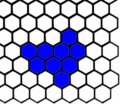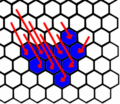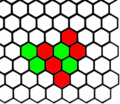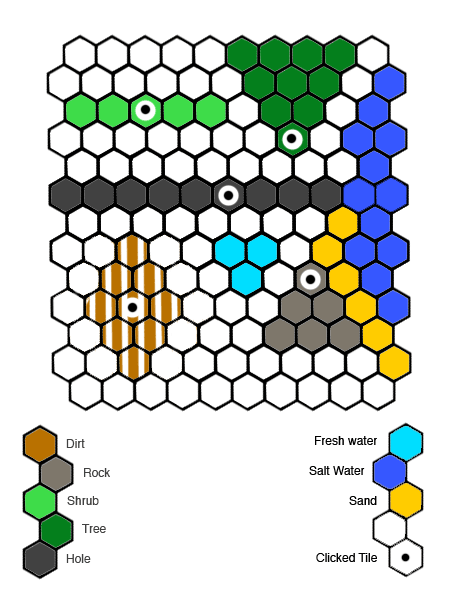GCPP:Proposal-Paddletail
Puzzle Codename: Paddletail
| Contact | |
| Username: | Ignisaer |
| Additional contact info: | On Midnight as Thaewyn. |
| Project forum thread: | |
Game concept
A board-flipping puzzle, like 'Lights Out', but with more patterns and behaviors.
Objective
Reveal resources in combination to clear them from the board. Planned as a foraging game.
Gameplay
The board fills with hexagonal (possibly square) pieces with terrain features on them. Behind most panels is a forageable material of some kind (See Category:Forageables). The other section of the display is a bag/basket/container of some sort showing a general amount of progress the player has made in that round.
Clickable Tile Types
Clicking on a Panel flips it face-up, revealing what material is hidden there. Depending on the terrain, however, surrounding tiles will also be flipped. (See the Legend image below)
- Rocks will flip the tiles immediately beneath them.
- Trees will flip tiles above them.
- Shrubs will flip tiles to the left and right.
- Dirt will flip tiles in a random direction (random each click).
Unclickable Tile Types
Some panels on the board cannot be clicked directly, but can be influenced by other tiles near them
- Fresh water contains forageables if flipped by another tile.
- Sand has a 50% chance of containing a forageable material if flipped.
- Salt water cannot be clicked and contains no forageable materials.
- Salt water will be constrained to the edges of the board, be fixed in position, and no new salt water tiles will drop into the grid, to make sure all boards are completable.
Clearing Tiles
If a group of the same fruit is showing at the same time (size of the group depends on the type of fruit), those tiles clear from the board, and the cleared fruit is added to the container. New tiles fall from the top to fill the empty spaces, but tiles that are already on the board and fall flip once for each row (so a tile that falls 3 rows will be in the opposite state than it began, but a tile that falls 2 rows will be back to the way it was).
Difficulty
The difficulty in the initial stages is very low, and should be mostly a matter of revealing as many tiles as possible.
Basic strategies are to remember what resources are behind which tiles, and try to do a single click that completes multiple sets. Combos are possible, in that a falling tile might flip face-up to complete a set, but these will likely be accidental.
At higher levels, the variety of materials on the tiles would make it more difficult to reveal complete sets of a single type, as trying to reveal more may cause flipped tiles to flip back over.
Walkthrough
1. The board fills up with tiles, all of which are 'face down'.
2. The highlighted hex is the one that was clicked on (in this case, a rock). The tile itself, as well as all those in its affected area, are flipped over, revealing materials.
3. Next, a tree tile is clicked. Note that since some of the affected tiles are face-up when the tree is clicked, they toggle back to being face-down.
4. A shrub is clicked, revealing more materials.
5. For the sake of demonstration, lets say the number of bananas required to make a group is 6. There are 7 bananas showing, so they are cleared from the board, and tiles from above settle down into the gaps.--Note that I kind of messed up the image here, heh. Tiles that fell did not flip, as they should have (this will cause quite a bit more chaos after a group is cleared). This image is mostly to show that tiles fall, and basically where they end up. I'll put up some dummy images to demonstrate flip-falling later...
6. Next, a dirt tile is clicked, revealing more bananas, but covering a mango.
7. Again, for the sake of demonstration, lets say the player is trying to collect mangoes, and clicks the same dirt tile to reveal it once again. However, since dirt tiles affect adjacent tiles randomly, other nearby tiles are affected instead.
Flip-falling
So, tiles flip over as they fall, based on the number of rows they descend. For each row, they flip once. So, tiles that flip go down 2 rows flip twice, and return to their original states. Tiles that fall only a single row flip once, and change states.
So for example, a large section of tiles is cleared, and the tiles above fall down to fill the spaces created.
Note that this does not mean that the green tiles are all face-down and the reds are face-up. If red tiles were previously face-down, they are now face-up in their new positions. Green tiles that were previously face-down remain face down, but in the process of flipping, they revealed what material they contain for a brief second.
Also note that this flipping and falling would continue to cascade upward until it reached the top of the field and new tiles are spawned to fill in the blanks.
Scoring
Scoring can go one of two ways, depending on how rewards are implemented.
If the results of foraging are directly related to what was earned in the game (for example, you harvest a group of passion fruit in the game, you get a unit of passion fruit as reward), then scoring will be related to how many clicks it took to fill up the container. EDIT - re-reading the guidelines, I noticed that one of the requirements is "Requires No Back-End Support". I'm not sure if this scoring method falls into this category, but just in case, I'm going to focus on the alternate scoring system.
If the results of foraging are randomized (or influenced by your score), then scoring would be based on a point system:
Resources
| Name | Amount per set | Value per unit | Set Value |
| Bananas | 5 | 4 | 20 |
| Carambolas | 5 | 8 | 40 |
| Coconuts | 4 | 5 | 20 |
| Durians | 4 | 15 | 60 |
| Gem | 3 | 50 | 150 |
| Gold ore | 3 | 90 | 270 |
| Limes | 8 | 4 | 32 |
| Mangos | 5 | 8 | 40 |
| Passion fruit | 6 | 8 | 48 |
| Pineapples | 5 | 8 | 40 |
| Pomegranates | 5 | 10 | 50 |
| Rambutan | 7 | 9 | 63 |
Ok, so here's the list of all possible pieces, as well as the number required for a set, and that set's value. The last column is the value of each individual fruit tile, to show the relative value of each type. This number is also used to calculate the value of overfills. Since complete sets are cleared automatically when enough are showing, creating an overfill will be rather difficult. Therefore, the point value of each fruit in the overfill is doubled.
For example, Pomegranates. A set consists of 5 fruit, with a default value of 50. Each individual fruit is worth 10 points. If you were to get an overfill set of 7 pomegranates, you would earn 90 points:
(Default set amount * fruit value) + (number of overfill * (2 * fruit value)) = total score
(5 * 10) + (2 * (2*10)) = 90
It should be noted that players who are skilled enough to make an overfill on a gold or gem set will generate lots of bonus points (a set of 4 gems would be worth 250, and a set of 4 gold ore would be worth 450!)
Rare resources
Gems and Gold ore will need to be accounted for in some way. I suppose if the results of foraging are generated randomly, then it won't matter much, but they should still pop up in the game somehow.
Combos and overfills (clearing more of a fruit than is required for a set) contribute to a hidden 'rare tile' meter. After this fills, a gem or gold material tile will drop into the field.
Variability
At higher skill levels, more 'rare' forageable materials appear. Also, certain special tiles will go into the mix. A hole might clear every tile in its row, collecting materials there instantly.
Multiplayer
Ok, I'm working on a multiplayer variant of this game. I don't think it warrants an entirely new proposal, but I am putting it on a different page: GCPP:Proposal-Paddletail-Multiplayer
End criteria
When the container is full of material, the round ends. The container holds a maximum of 50 pieces, but all pieces collected in the last move will be counted as well (if there's 48 in the container, and you clear 5, all 53 will be counted).
Calculating Final Score
Final score is calculated by dividing the total point value of all the materials collected by the number of moves it took to collect them.
On the lowest end would be a container full of 56 Limes (the least valuable), with a point value of 224. Taking 20 clicks, the final score would be 11.2.
On the other end, a full bushel of Rambutans (48 rambutans with 3 gems thrown in for good measure) would have a point value of 870 (higher if they got any overfill). Taking a few more clicks to be cautious (lets say 25), would result in a final score of 34.8.
So the final result scale would be something like this:
- Booched - <10
- Fine - 10-20
- Good - 20-30
- Excellent - 30-40
- Incredible! - 40+
(This is of course subject to much balancing/tweaking =p)
Difficulty scaling
At higher difficulty levels, rotten/spoiled fruit will come into the mix. Spoiled fruits can still be used to complete sets, but will add no points to your score. Rotten fruit will behave the same, but will subtract points from your score.
Crafting type
Foraging
Known problems
Notes
Since this is a game for Foraging, I don't think it needs to be too difficult. Foraging's success, in reality anyways, is only based on time and a little luck. If you take enough time looking for something, you'll eventually find it, that sort of thing.
Images










